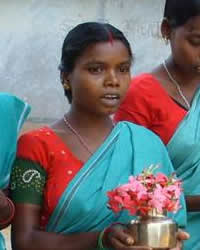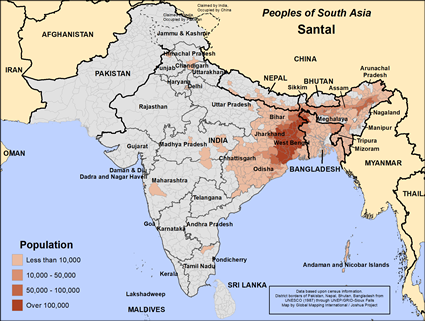Santal (Sawntal) in Bhutan

Photo Source:
Find Your Feet - Flickr
Creative Commons
|

Map Source:
People Group data: Omid. Map geography: UNESCO / GMI. Map Design: Joshua Project.
|
| People Name: | Santal (Sawntal) |
| Country: | Bhutan |
| 10/40 Window: | Yes |
| Population: | 5,500 |
| World Population: | 7,894,500 |
| Primary Language: | Santhali |
| Primary Religion: | Hinduism |
| Christian Adherents: | 2.59 % |
| Evangelicals: | 0.00 % |
| Scripture: | Complete Bible |
| Ministry Resources: | Yes |
| Jesus Film: | Yes |
| Audio Recordings: | Yes |
| People Cluster: | South Asia Tribal - other |
| Affinity Bloc: | South Asian Peoples |
| Progress Level: |
|
Introduction / History
The Munda-Santal are comprised of nine different, but very closely related people groups. Those in India are distributed throughout the states of Bihar, West Bengal, and Odisha. Most of the tribes live in the hilly areas of the Chotanagpur Plateau, located in southern Bihar. Others prefer living in the plains. The seven groups who occupy territory farther north include the Santal (of India, Nepal and Bhutan), the Bhumij, the Koda, the Mahili, the Ho, and the Agariya. The two remaining groups, the Juango and the Gadaba, are further south, nearer the coast of the Bay of Bengal. The language of the Munda-Santal, called Munda, belongs to the Austro-Asiatic language family. However, the Santal people speak their own language, Santhali.
In India, the culture of the Santal is quickly changing under the impact of industrialization, new communication links, tribal welfare schemes, and community development projects. This is less pronounced in Bhutan, a nation that is changing very slowly.
Traditions regarding the origin of the Munda-Santal tribes are uncertain. Some believe they originated with new settlers from Southeast Asia 3,000-4,000 years ago.
What Are Their Lives Like?
Most of the Santal population in Bhutan depends on farming for survival. Some rural families depend on village or cottage industries, such as weaving. They supplement their meager agricultural earnings with hunting and gathering. Both men and women work to bring home adequate income for their families. The weekly market plays an important part in the Santal's economy.
Santal settlements are usually in river valleys; deforested, eroded areas; and mineral and industrial belts. Most of the people live in clustered villages or villages on one street.
They divide the Santal into clans which recognize a common ancestor. The clans often marry those who are from other tribes; however, there are smaller sub-tribes who are permitted to marry only those within their group. There is also a bachelor's dormitory in all Munda-Santal groups, including the Santal.
The Santal have a fascinating artistic heritage, especially in music and dance. Most of their villages have a dance floor where the village priest offers worship. Headmen run their villages. Most conflicts within the tribes concern land rights or marriage.
What Are Their Beliefs?
The Santal tribe tends to preserve their own beliefs, values and separate identity. Most are Hindus, while the others practice ethnic religions. Today, their supreme god is the sun god. There is a Christian minority among them in each of the four countries where they reside.
What Are Their Needs?
In places where the gospel is being preached to the Munda-Santal tribes, the listeners almost immediately receive Christ after the village council talks it over. These precious tribes are ripe unto harvest; they simply need people to show them the way to the true God. This is easier said than done in Bhutan, but God can make a way!
Prayer Points
Ask the Lord to thrust out Holy Spirit anointed workers who are willing to share Christ with the Santal people in Bhutan.
Ask the Holy Spirit to soften the hearts of the Santal towards Jesus and his gospel so that they will be receptive.
Ask the Lord to raise up a church planting movement among the Santal people in the 2020s.
Pray that the doors of Bhutan will soon be open to missionaries.